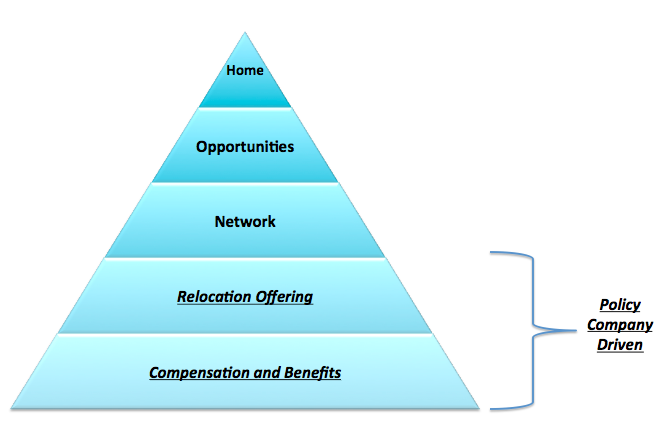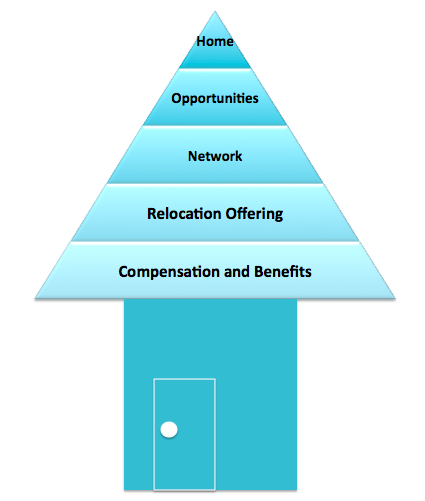
What we can learn from Maslow’s Hierarchy of Needs in the world of global mobility
Global mobility managers care deeply about their employees’ relocation experience. At Topia, we interact daily with global mobility managers from different industries and the common concern is “how do we deliver a great experience to employees”? To understand how to deliver a great program is to understand what motivates employees to relocate or go on assignment.
Borrowing from Abraham Maslow’s psychology theory on the hierarchy of needs, we’ve identified key factors that a program should have to attract and retain an employee’s motivation and interest throughout their international relocation. Maslow explains that the foundational parts of needs must be met first before considering the other levels. Noted in the pyramid below, these stages include: physiological, safety, belonging, esteem and actualization.

Fig; Maslow’s Hierarchy of Needs
At the foundational level is physiological. In the traditional model, these would be considered air, food, water, sleep, etc. In the global mobility world, this level would be the baseline of compensation and benefit for employees. Is the offer salary competitive or better than home country? What benefits will the employee be gaining, or worse, losing?
What can global mobility do?
- Provide a COLA to make up any living standard differences
- Consider a settling in allowance
- Map out what benefits the employee may gain or lose
Once the foundation is addressed, the next level is safety and these are the logistics and relocation-specific benefits. Where would the employee live the first few weeks? What would they do with all their stuff? For employees, these factors are top of mind and also lead to the most stress and escalations during a move.
What can global mobility do?
- Offer temporary housing to employees during the first few weeks in their host location
- Consider including Destination Services Provider support to help employees find a place to live, get set up with banking and registrations, school searches, and more
- Provide shipment of household goods
The first two levels can be met with how the policies are designed and structured. A well executed policy can support the initial stages of relocation and serves as the backbone of the relocation experience.

The third part of Maslow’s model is belonging. Relocation and assignments can be one of the most exciting adventures of an employee’s life. At the same time, expat life can also be incredibly lonely. For some employees, it is a solo journey where they have packed up and picked up their lives far away from family and friends. Their new city may not offer a large network and it becomes even lonelier when local customs and languages are different.
If relocating with family, expat spouses and children provides companionship but offers its own challenges. For spouses and children, they’ve left careers, schools, family and friends to relocate and unlike the employee, they don’t have a built in network at work. In a 2013 EY Global Mobility Effectiveness Survey, they cited that 65% of failed assignments or early repatriation was due to “lack of adequate schools, insufficient housing, inadequate work opportunities for a spouse.”
What can global mobility do?
- Cultural and language training to help the employee get acquainted with their new country
- Spousal support such as career counseling or networking events
- Buddy up the employee with a local coworker or offer mentorship opportunities. Some organizations even include the relocating employee into onboarding classes whether new or transferred hire to provide a network. For assignees, pair them up with buddy back in their home location as well so they don’t lose touch with the home office and which can help with repatriation
- Organize office expat meet ups
- Encourage employees to connect with university alumni networks
Once belonging has been realized, employees can now look at esteem. Esteem is the level where we see the employee and family become adapted to their host country. For the employee, this level is also achieved by being assigned to exciting projects and being provided developmental opportunities unavailable to them back home.
Employees that are identified to relocate or go on assignment are often times filling local talent gaps, part of a talent development program, or identified as a high potential. Once the first three layers of the hierarchy have been achieved, the employee can focus on reaching their potential at work.

What can global mobility do?
- Check in to see how the employee is adjusting in the new office and country
- Consider implementing a feedback process for the first three months, six months and a year after the relocation and after repatriation occurs
- Conduct post-assignment feedback process
The final level is self-actualization which in the world of mobility can be described as when the employee feels integrated into the country. It can be the tipping point from when the employee starts referring to “going home” as going back to their host country. This stage, as it is in the original Hierarchy of Needs, is always in progress.
What can global mobility do?
- Support the other parts of the pyramid. When employees’ needs are met, employees can focus on what they need to do to make a new place feel like home.
Relocation is a personal experience. There isn’t a one size fits all approach. By understanding the motivations and needs of employees during the relocation process can in turn elevate their experience.


